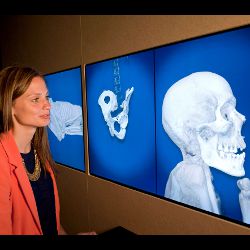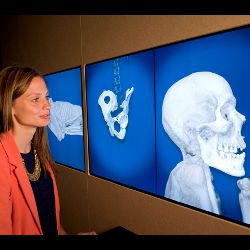
In 1887, a uniquely shaped and mysterious mummy caught the eye of an important museum collector and hitched a ride from the storehouse of an unknown antiquities dealer in Egypt to the vast vaults of the British Museum in London.
No question, it was a woman. Unlike most of the cases carrying the wealthy dead of ancient Egypt, which depicted their inhabitants in their embalmed state, her case was painted like a woman in the prime of her life. Metal eyes gazed out from a wooden facemask. A painted dark cloak covered the body of the case, and from its base, reddish feet with silver-painted toenails emerged. Who was she?
The first revelations came in the 1960s, when British Museum staff blew the dust off their mummy cases and ran several of them whole through X-ray scanners. Experts were surprised to find one-third of this case empty, and the rest filled by the preserved remains of a tiny female. The case was fashioned like the shapely curves of a full-grown woman, but carried a girl. Museum researchers concluded she was no older than 12.
Using computer tomography (CT) devices, researchers could now explore their mummies layer by layer, without touching the case or wrapping.
In 1975, the coffin was cleaned and inscriptions found on the case included the name of the dead girl: Tjayasetimu, temple singer. This made sense; the children of wealthy families traditionally took these roles. Also, child mummies were a rare find. Tjayasetimu would not have been preserved unless her parents could afford the lavish last rites.
It was not until the mid-2000s that British Museum staff really got a more-complete picture of this girl’s identity. By then, museums switched to scanning their mummies with medical computer tomography (CT) machines. X-ray scans revealed bony outlines, but CT searched for density. Without touching the case or wrapping, researchers could now explore their mummies layer by layer.
Under Tjayasetimu’s wrappings, researchers were surprised to see the delicate features of an exquisitely preserved face, and clumps of hair that would have hung to her shoulders. The scans revealed adult teeth in her jaws, waiting to push out, had she lived for another year.
“The embalmer has done a brilliant job,” says John Taylor, a curator at the British Museum specializing in ancient Egypt and funerary archaeology. From the length of her leg bones, the teeth in her jaw, and the styling of her hair—all viewed through CT scans—Taylor and his colleagues concluded Tjayasetimu was probably seven, maybe pushing eight, when she died.
“That was quite a revelation to be able to pinpoint her age with that level of accuracy,” Taylor says, and much of this was possible only because of advanced CT scanning technology, and the 3D visualizations that followed.
Today, Tjayasetimu rests beside seven other mummies in a new exhibit at the British Museum. Visitors still stand behind the glass of the display case, but on touchscreens mounted beside each, they can take a virtual tour inside the mummy cases, zooming in and peeling back layers of wood, plaster, and linen.
The British Museum is not alone in laying thousand-year-old artifacts next to cutting-edge technology in its latest public exhibits.
Museums all over the world are using a variety of scanning techniques to study fragile historical objects and uncover secrets that were previously out of their reach.
The techniques have filled in stories about individuals and whole cultures. Also, digitizing samples allows more researchers access for longer periods. On display, the new technology offers museum visitors a chance to share in an explorer’s moment of discovery.
“This is the closest you’re doing to get to the ‘eureka’ moment of seeing something unexpected,” says J.P. Brown, Regenstein Conservator at Chicago’s Field Museum. “There’s something about being able to manipulate the specimens which is interesting and exciting. I don’t think you get the same sense of discovery from looking at illustrations.”
Leading the scanning team at the Field Museum, Brown has had his share of ‘eureka’ moments.
In 2010, the team was scanning a female Peruvian mummy, arranged, as these traditionally are, in the fetal position. As the first scans showed up, they saw a rounded object, which looked like a broken vegetable gourd traditionally packed with stored food. When they looked closer, they realized that gourd was the disconnected skull of a dead infant, probably buried with its mother. Though the Field Museum has seen a number of “multiple burial bundles” (many individuals wrapped within the same mummy casing), this was the only one they have found with a baby in it, Brown says.
In the spring of 2012, the Field Museum unveiled a new mummy exhibit titled “Opening the Vault.” As at the British Museum, exhibits were accompanied by large touchscreens. Visitors looking at the real mummy from behind the display glass could virtually explore the insides of the box.
“You just don’t realize when you look at it in drawings, how much of an Egyptian mummy is linen wrappings. It’s a heck of a lot of wrappings,” Brown says.
Sliced like Salami
Archaeologists were using CT scanning as a research tool back in the mid-1950s, but it wasn’t until the graphics-processing and 3D-visualization revolutions of the mid-2000s that museum staff realized the data could be put on display.
Brown explains that a CT scanner is “basically a salami slicer” capturing images of virtual sections of the insides of a carefully wrapped mummy. After the flat slices have been stored by the computer, it is the job of a person—part artist, part programmer, part researcher—to stitch together the two-dimensional data into a colorful, engaging interactive exhibit, or a life-like rendering that gives researchers a realistic view of the insides of the object.
Museums all over the world are using a variety of scanning techniques to study fragile historical objects and uncover secrets that were previously out of their reach.
Among the leaders of this craft is the Interactive Institute Swedish ICT, an experimental information technology and design research company that has been converting technology geared for hospitals and clinics into teaching and research tools.
Staff at the Interactive Institute collaborated with the Field Museum to build the displays for the “Opening the Vault” exhibit. The Interactive Institute has been involved with 15 other interactive exhibits across the world, at places like London’s British Museum and the Smithsonian Institution in Washington, D.C.
The group has scanned everything from mummies to Martian meteorites to geckos, says Thomas Rydell, studio director, who adds that the real challenge comes later: “When you have this scan, you have to decide what you want to tell your audience about it.” A visitor only stops at a display for two or three minutes, so what is presented “has to be super-intuitive.”
At Stockholm’s Museum of Mediterranean and Near Eastern Antiquities museum, visitors can get even closer to history. One of the museum’s eight resident mummies is a 2,300-year-old Egyptian priest named Neswaiu, an important man preserved in an ornate and intricately decorated mummy case. When staff scanned Neswaiu, the CT scans revealed several amulets placed inside the wrappings, positioned at strategic locations on his body. The scans picked up the details of a falcon-shaped amulet, which the team then converted into 3D-printed replicas.
Now, as museum visitors view Neswaiu’s mummy from behind the glass of the display case, they can run their fingers over a printed amulet identical to the one touching the priest’s body.
There is a thrill to that, Rydell says. “I’m holding something in my hand that someone placed under the wrapping several thousand years ago.”
Age of the ‘Laser Cowboys’
Museums all over the world are reaching for that same accessibility, relying on 3D scanning and printing techniques to achieve realistic replicas of ancient objects.
At the Smithsonian Institution’s National Museum of Natural History, laser-assisted 3D scanning and replication is under way on a grand scale.
In November 2013, the museum launched the Smithsonian X 3D collection on its website, with the goal of making scores of artifacts from the museum’s collections, only 1% of which are on display, accessible anywhere in the world. As a result, for example, a flight history enthusiast from Auckland, New Zealand, can use a home computer to view a visualization of the Wright brothers’ 1903 airplane from any angle, or zoom in to view the seams and detailing on Amelia Earhart’s flight suit.
Unlike the layer-by-layer exploration of mummies with CT, the Smithsonian’s laser scans only scour the surface of an object.
Besides giving visitors are great way to explore the Institution’s trove of age-old wonders, the tools are valuable to researchers as well.
In June, the museum revealed the largest printout of its data yet: a scale model of a whale fossil, embedded in the ground exactly as it was when Smithsonian paleontologist Nicholas Pyenson first saw its bones peeping out of a roadcut in the Chilean desert in 2011. “The whale fossil is a great example of how we can take actual scientific data from the field and replicate it for a museum audience,” explains Gunter Waibel, director of the Digitization Program Office at the Smithsonian Institution.
The fossil trove, which contained 40 dead baleen whales between six million and nine million years old, was uncovered by a road-building company midway through expanding the Pan-American Highway. The road was growing, and the paleobiological treasure trove was in jeopardy so, the story goes, the Smithsonian called in its scanning specialists, Vince Rossi and Adam Metallo, 3D Program Officers who have come to be known as the “laser cowboys.” As Smithsonian Magazine would later report, the team took an emergency trip to Chile and spent two weeks scanning the fossils in the very same soil layers in which they were found, preserving clues that paleontologists would need in reconstructing how the whales got there in the first place.
In June, the museum revealed the largest printout of its data yet: a scale model of a whale fossil, embedded in the ground exactly as it was found.
The brand-new 3D-printed exhibit, a product of those first scans, is a happy bonus.
Gee-whiz displays and lush 3D renderings may seem like they are stealing the spotlight from genuine, original historical objects, but that is not the case, Waibel insists. The museum’s goal is to make the collections and specimens more accessible to the public and to provide “an alternate way to interact with history, science, and art,” says Waibel.
“Nothing will ever replace the experience of viewing an original artifact in person,” he says.
Further Reading
Taylor, J., Antoine, D.
Ancient Lives New Discoveries: Eight Mummies, Eight Stories, British Museum Press, London, England, 2014. http://amzn.to/YAqfAO
Pyenson, N., et al.
Repeated mass strandings of Miocene marine mammals from Atacama Region of Chile point to sudden death at sea. Proceedings of the Royal Society, B, 281, February 2014.
Reconstructing the mummy Neswaiu with Autodesk ReCap http://bit.ly/1pLvqYG
“Cerro Ballena.” Cerro Ballena. Smithsonian Institution, n.d. Web. 11 July 2014. http://cerroballena.si.edu/
Figures
 Figure. A British Museum staffer views scans of the mummy of ‘Gebelein Man B,’ part of the interactive ‘Ancient Lives, New Discoveries’ exhibition that incorporates state-of-the-art technology enabling visitors to virtually explore inside mummy cases and examine bodies underneath the wrappings.
Figure. A British Museum staffer views scans of the mummy of ‘Gebelein Man B,’ part of the interactive ‘Ancient Lives, New Discoveries’ exhibition that incorporates state-of-the-art technology enabling visitors to virtually explore inside mummy cases and examine bodies underneath the wrappings.




Join the Discussion (0)
Become a Member or Sign In to Post a Comment